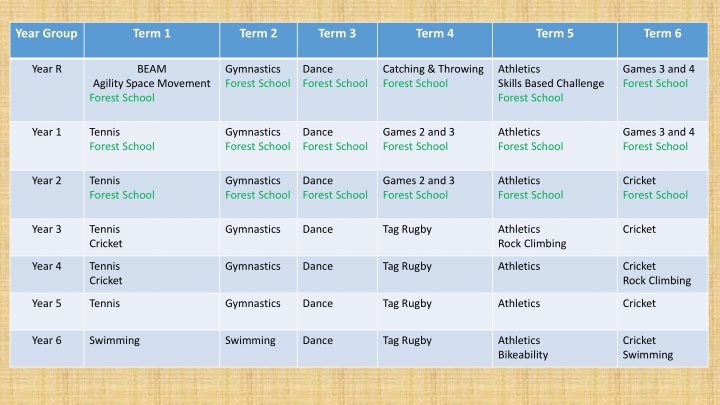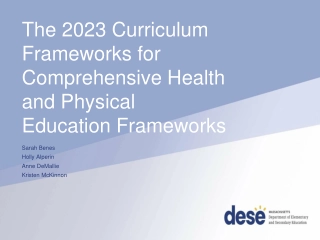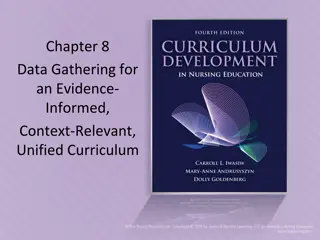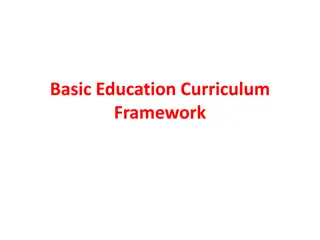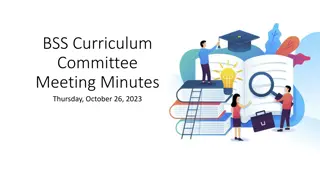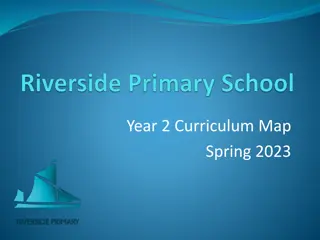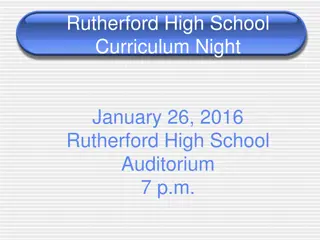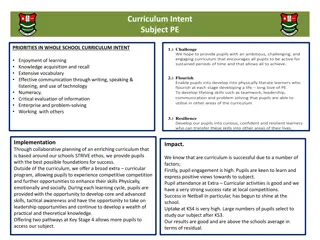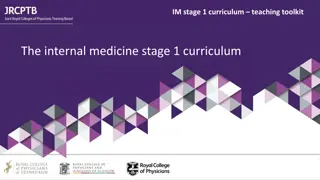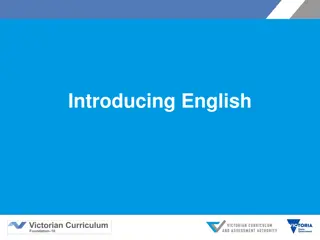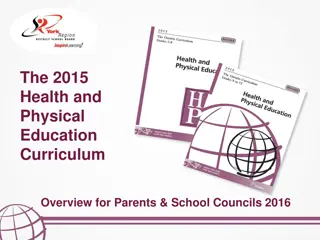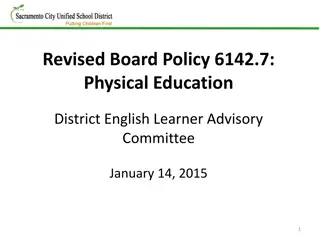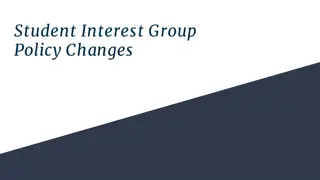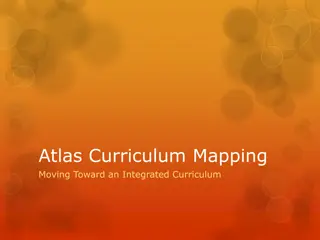Physical Education Curriculum Overview for Various Year Groups
The physical education curriculum overview covers a range of activities and sports for different year groups, including gymnastics, tennis, cricket, swimming, dance, tag rugby, athletics, and more. Each year group focuses on specific skills and activities tailored to their age and abilities, with qualified coaches and instructors guiding the students through the programs.
Download Presentation

Please find below an Image/Link to download the presentation.
The content on the website is provided AS IS for your information and personal use only. It may not be sold, licensed, or shared on other websites without obtaining consent from the author.If you encounter any issues during the download, it is possible that the publisher has removed the file from their server.
You are allowed to download the files provided on this website for personal or commercial use, subject to the condition that they are used lawfully. All files are the property of their respective owners.
The content on the website is provided AS IS for your information and personal use only. It may not be sold, licensed, or shared on other websites without obtaining consent from the author.
E N D
Presentation Transcript
Year Group Term 1 Term 2 Term 3 Term 4 Term 5 Term 6 Year R BEAM Gymnastics Forest School Dance Forest School Catching & Throwing Forest School Athletics Skills Based Challenge Forest School Games 3 and 4 Forest School Agility Space Movement Forest School Year 1 Tennis Forest School Gymnastics Forest School Dance Forest School Games 2 and 3 Forest School Athletics Forest School Games 3 and 4 Forest School Year 2 Tennis Forest School Gymnastics Forest School Dance Forest School Games 2 and 3 Forest School Athletics Forest School Cricket Forest School Year 3 Tennis Cricket Gymnastics Dance Tag Rugby Athletics Rock Climbing Cricket Year 4 Tennis Cricket Gymnastics Dance Tag Rugby Athletics Cricket Rock Climbing Year 5 Tennis Gymnastics Dance Tag Rugby Athletics Cricket Year 6 Swimming Swimming Dance Tag Rugby Athletics Bikeability Cricket Swimming
Year R -Term 1 BEAM/ Agility, Space Movement Year R -Term 1 BEAM/ Agility, Space & Movement BEAM - Balance, education and movement. This is a programme that provides the school with an understanding of who may need early support when it comes to fine and gross motor skills. Over the first term the children will be assessed on various balances, movements and ball skills. Agility, Space & Movement Exploring different jumping movement skills. Listening, observing and showing an awareness for themselves and of others Moving fluently, changing direction and speed. Moving with control, coordination and imagination. Travelling using different movements and directions.
Years 1-5 Term 1 Tennis Years 1-5 Term 1 Tennis Tennis is taught by an LTA qualified Tennis Coach She delivers the LTA programme Over the course of their time here, our children will be taught: How to stand, ready position. How to move across the court, maintaining balance and appropriate body position. Eye/hand co-ordination to field and strike a ball. This will develop into developing their ability to play a full range of tennis shots Employing tactical awareness to defeat an opponent.
Year 3 -Term 1 Cricket Year 3 -Term 1 Cricket Year 3 Cricket Children will be taught cricket by Adrian Crust, the KCCC community cricket coach, through the Chance to Shine Programme. He will introduce children to the game of cricket and develop their basic skills of holding the bat, striking the ball and bowling and fielding the ball.
Year 6 -Term 1 Swimming Year 6 -Term 1 Swimming Year 6 Swimming Children will be working towards the stated goals of the PE curriculum, which are: To be able to swim 25m unaided. To use a range of strokes effectively And to perform safe self-rescue in different water-based situations. They will be assessed for ability and according to the results, grouped to achieve the goals.
Year R -Term 2 Gymnastics Year R -Term 2 Gymnastics Year R- Gymnastics Children will be; Learning to use different ways of travelling across mats. They will be able to demonstrate basic balances using patches and points. Pupils will demonstrate a variety of jumping patterns and be able to perform some basic gymnastic rolls.
Year 1 Term 2 Gymnastics Year 1 Term 2 Gymnastics Year 1 Gymnastics Children will be; Exploring and using space effectively using agility, balance and coordination skills. Balancing using different parts of the body, exploring points and patches (Beginning to on apparatus). Learning to take weight on hands and feet. Learning to copy and name basic and advanced low-level shapes. Linking shapes and rolls to form a short sequence. Exploring different styles of travelling: under, over and through. Beginning to travel on apparatus. Jumping and landing safely, whilst exploring different jumping techniques Copying, mirroring and creating a small routine and matching actions.
Year 2 Term 2 Gymnastics Year 2 Term 2 Gymnastics Year 2 Gymnastics Children will be; Exploring medium level shapes with linking, mirroring and balances. Comparing and contrast low and medium level shapes with confidence and rehearse them. Rolling safely using a variety of rolling techniques. Incorporating two shapes into a sequence. Performing low level shapes with some precision and perform shapes in flight. Using apparatus (extended) safely with entrances, exits, balances and including medium level shapes. Jumping and land safely using apparatus, including from a variety of heights, directions and landings Modelling, linking and mirroring of low-level shapes. Including balancing & travel with a partner using mirroring technique.
Year 3 Term 2 Gymnastics Year 3 Term 2 Gymnastics Year 3 Gymnastics Children will be; Performing short sequence with: low and medium level shapes; with matching and mirroring; contrasting shapes with some linking. Taking weight confidently on hands (developing core strength) and roll safely, exploring different rolling methods (Front and backward Rolls). Performing a wide range of shapes and balances on apparatus. Performing shapes in flight, on and off a piece of apparatus, including turn, twist and spin. Perform a range of jumps and leaps from varying heights and on a vault. Perform mirrored and matching travels and balances with a partner.
Year 4 Term 2 Gymnastics Year 4 Term 2 Gymnastics Year 4 Gymnastics Children will be; Performing & evaluating a routine: matching balances & stands; with matching balances on apparatus; with contrasting balances; with contrasting balances on and over apparatus; with linked balances on and over apparatus. Performing a shoulder and headstand safely without support. Performing a forward roll with appropriate entrances and exits including on, off and over apparatus. Linking movements by performing jumps, turns and pivots. Completing mirroring actions along different pathways and levels, including basic rolls
Year 5 Term 2 Gymnastics Year 5 Term 2 Gymnastics Year 5 Gymnastics Children will be; Performing a range of routines with rolling; including jumping rolls, build into rolling from and into a pike position. Perform both a stag jump and a split leap. Progressing from a cartwheel to a perform a round-off. Performing Cat Springs. Performing forwards and backward rolls with a range of entrances and exits. Learning a headstand, transitioning into a forward roll and incorporating as part of a routine. Vaulting safely with a range of entrances and exits and then into rolling, building up to various landings on and over a vault. Planning a sequence of movements on apparatus both individually and as a group, in time with each other to form a routine.
Year 6 Term 2 Gymnastics Year 6 Term 2 Gymnastics Year 6 Gymnastics Children will be; Incorporating stands into cannon and or unison performances. Performing rotation, balances and stands in unison and cannon. Performing shoulder, headstands, cartwheels and handstands safely without support. Combining balancing & travelling to produce a floor routine including matching. Incorporate apparatus. Producing mirroring routine with a partner on apparatus. Rolling in sequences on, off and over apparatus. Including into partner routines. Performing to roll on, off and over apparatus within routines. Including counterbalances and counter tension balances.
Year R Term 3 Dance Fairy Tales Year R Term 3 Dance Fairy Tales Year R Dance Fairy Tales Children will be; Interpreting music to inspire movement. creating movement in the style of certain characters. creating movement with a partner. Learning how to perform a duet. creating a dance that resembles the characters of a fairy tale. Learning how to stay in time with peers. Year R Dance Farm Learning to travel while staying in time with music Learning how to roll safely Learning to rehearse a dance, relating to farm animals Participating in groups.
Year 1 Term 3 Dance Year 1 Term 3 Dance Year 1 Children will be; Creating a class performance. Selecting and using a variety of movements to form a short dance phrase. Performing a variety of movements to form a group dance phrase. Exploring a range of movements.
Year 2 Term 3 Dance Year 2 Term 3 Dance Year 1 Children will be; Creating a class performance and observe others work and give feedback using simple dance vocabulary. Selecting and exploring an air pattern, jump and shape to form a short dance phrase. Working as a group to recall choreography, rehearse and refine ideas. Performing a variety of movements to form a group dance phrase; exploring turning, rotation, circular shapes/ dynamic through movement. Exploring movements considering size of movements, tempo, dynamics, floor pattern, air pattern, levels and shape.
Year 3 Term 3 Dance Year 3 Term 3 Dance Year 3 Dance Children will be; Organising sections of dances to create one piece, working in sync with other group members. Assess others work. Working as a group to select learnt positions and movements to create short dance phrases. Use choreographic devices to enhance dance phrases, including choregraphing a solo. Selecting and explore a variety of movements, responding imaginatively to a range of stimuli. Performing movement actions individually, with partners, a group and whole class. Exploring, repeating and linking a range of actions with coordination and memorise. Responding to a beat, using music as a stimulus to influence dance.
Year 4 Term 3 Dance Year 4 Term 3 Dance Year 4 Dance Children will be: Developing dance when creating one piece, performing in unison and sync with other group members in front of the class. Self- assess and assess peers work, and give feedback using appropriate dance vocabulary Developing synchronisation when working in a group including to different rhythms. Respond to teacher instruction to create a choreographed dance routine. Developing choreographic skill incorporating more free creative thinking. Developing good co-ordination within a sequence of movements. Movements articulate the style of dance well. Use music to influence movement with increasing skill.
Year 5 Term 3 Dance Year 5 Term 3 Dance Year 5 Dance Children will be; Learning, rehearsing and performing choreographed dance phrases of increasing complexity. Self-assessing and assess others work and give critical feedback using appropriate vocabulary. Creating versatile movements within a dance sequence including a range of directions. Choreographing a sequence of movements that use contact between two or more people. Using a range of dance techniques to develop their movements. Developing movements to incorporate at least one lift in a sequence of movements. Identifing floor plans and use within their movements, including starting and finishing area.
Year 6 Term 3 Dance Year 6 Term 3 Dance Year 6 Dance Children will be; Performing choreographed dance narrative, improving movements, developing timing and spacing. Assessing self and others with increasing critical feedback and suggested actions for improvement using apt and precise language. Exploring and linking a number of movements and patters. Using choreographed movements and patterns to tell a narrative; adapt movements in a more creative style; utilise a floor plan. Using choreographed movements and patterns to tell a narrative; adapt movements in a more creative style; utilise a floor plan. Using gymnastic equipment to create improvised movement. Allowing different parts of the body to lead and influence the rest of the movement; using a range of levels tempos, and contact work.
Year R -Term 4 Catching Throwing Ball skills Year R -Term 4 Catching & Throwing Ball skills Year R Catching & Throwing, Balls skills Children will be; Learning to use both underarm and overarm throws with some accuracy when using a beanbag or tennis ball. practising rolling, throwing and stopping circular equipment. Learning to be able to catch a moving ball. Learning how to move with confidence in different ways, whilst holding an object. Developing a range of different ball skills including bouncing. Performing underarm and overarm throwing actions.
Year 1 Term 4 Games 23 Year 1 Term 4 Games 2&3 Year 1- Games Children will be: Carrying and balancing equipment whilst changing speed and direction. Showing control and accuracy when throwing and aiming. Gaining rhythm when throwing and striking a ball. Striking and kick a moving ball with accuracy and control. Understanding the concept of dribbling and the skills required. Engaging in team games, showing the skills learnt in previous lessons Understanding what attacking and defending is using simple practices Demonstrating basic defending skills Defending a space against other pupils in small sided games. Demonstrating basic attacking skills Moving past a defender using quick movements.
Year 2 Term 4 Games 2 3 Year 2 Term 4 Games 2 & 3 Year 2- Games Children will be: Performing kicking skills with control and accuracy. Performing underarm and overarm throwing with control Completing and performing net type activities with control Sending and receiving a ball using a tennis racket with control. Demonstrating a range of striking and gathering skills. Striking and gathering skills into small sided games Moving with a ball during a game. Using space whilst passing and receiving a kicked ball. Throwing & catching to pass and receive a ball in a game. Attacking & defending in a game, making and denying space. Developing tactics when shooting at and protecting targets. Attacking and defending skills into invasion games.
Year 3 Term 4 Tag rugby Year 3 Term 4 Tag rugby Year 3 Tag Rugby- Children will be; Learning to pass and receive a rugby ball correctly. They will learn how to hold the ball and the motion for passing. They will learn the target area on the body for a pass and how to have their hands ready to receive it. They will be introduced to how we pick a rugby ball up and how we dot it down. They will be introduced to how to tag an opponent They will have the first instruction in stepping to avoid a tackle.
Year 4 Term 4 Tag rugby Year 4 Term 4 Tag rugby Year 3 Tag Rugby- As well as reinforcing prior learning, they will be introduced to these new concepts: Learning to take a step to pass a ball a greater distance. Learn to pass with sympathy, and how to pop pass the ball. They will be introduced to running on a shoulder to support a player. The ability offload quickly in the tackle. Further development of how to step away to avoid tackles. How to operate as a defensive line to prevent a team breaking through.
Year 5 Term 4 Tag rugby Year 5 Term 4 Tag rugby Year 3 Tag Rugby- As well as reinforcing prior learning, they will be introduced to these new concepts: Consolidating their catching and passing abilities. Developing their attacking styles, with players knowing how to run support lines. Understanding the concept of breaking a line to allow a scoring opportunity for a team mate. Developing their ability to defend as a team, employing a full back.
Year 6 Term 4 Tag rugby Year 6 Term 4 Tag rugby Year 3 Tag Rugby- As well as reinforcing prior learning, they will be introduced to these new concepts: Consolidating their ability to work as a team in both attack and defence. Developing their ability to re-group in either scenario. Identifying mistakes in play and developing their ability consequently.
Year R Term 5 Skill based Challenges Year R Term 5 Skill based Challenges Year R Skills based challenges Children will be; Working towards achieving their personal best for: Catching challenges, rolling challenges, throwing challenges, kicking challenges, bouncing challenges and hitting challenges.
Year R Term 5 Athletics Year R Term 5 Athletics Year R Athletics Children will be; Developing effective jumping and throwing techniques. Jumping over low level hurdles. Throwing in varying ways, distances and develop accuracy. Moving at varying speeds. Learning how to demonstrate an effective standing sprint start. Jumping & landing safely to different distances Learning how to perform a chest push
Year 1 Term 5 Athletics Year 1 Term 5 Athletics Year 1 Athletics Children will be; Running fast from a standing start developing speed and coordination Jumping and throwing, developing coordination, agility and rhythm. Running and kicking for accuracy and speed. Learning basic throwing, catching and skipping skills, developing hand-eye coordination and ball handling skills. Learning basic bowling and step throwing with agility and with skill.
Year 2 Term 5 Athletics Year 2 Term 5 Athletics Year 2 Athletics Children will be; Developing awareness of speed when running a short distance, including control and fluency in movements; understanding how their body reacts when running. Jumping for distance. Developing awareness of space, height and distance. Adjusting and making changes to running speed when completing different distances. Throwing and aiming with accuracy towards a given target. Choosing the best way to throw different pieces of equipment dependent on size & weight.
Year 3 Term 5 Athletics Year 3 Term 5 Athletics Year 4 Athletics Children will be; Running a relay and change over the baton appropriately including passing a baton from standing start. Jumping for distance including jumping from a standing start. Developing skills to jump further distances. Learning basics of hurdling, keeping head same height throughout jumping. Run for speed, including over longer distances. Learning basics of hurdling, keeping head same height throughout jumping. Developing throwing skills further distances and a range of techniques.
Year 3 Term 5 Rock Climbing Year 3 Term 5 Rock Climbing Year 3 Rock Climbing Children will be completing the NICAS level 1 course. This will involve them: Learning how to connect themselves for roped climb Developing their ability to recognise passages which allow three point of contact climbing. Increasing their self-confidence to succeed higher climbs.
Year 4 Term 5 Athletics Year 4 Term 5 Athletics Year 4 Athletics Children will be; Communicating as a team to make relay changeovers. Improving running techniques including the sprint finish and maintaining sprint pace. Can challenge self to jump for distance including measuring performance. Jumping for height including high over obstacles. Sprinting, challenge self and recording performance. Throwing for distance challenging self and recording performance. Using overhead heave and fling throw.
Year 5 Term 5 Athletics Year 5 Term 5 Athletics Year 5 Athletics Children will be; Learning to run relays, running in a given zone, changing baton over with increased skill. Developing jumping for distance (triple jump); jumping in different ways and competing competitively Developing running for speed including sprint from a start finish and sprinting further distance over a given time. Developing hurdling skills, including the role of the lead and trail leg; applying skill to competitive situation. Developing throwing skills using a variety of techniques. Throwing javelin from a standing start.
Year 6 Term 5 Athletics Year 6 Term 5 Athletics Year 6 Athletics Children will be; Competing in a variety of athletics type races; adjusting running styles from sprinting to long distance. Using correct techniques for all jumps, challenging self to jump further distances. Running with greater fluency & speed, including hurdling; using the correct stride pattern. Analysing the changes in speeds when sprinting and hurdling. Using the correct techniques for all throws, measuring accurately, challenging to throw further distances.
Year 6 Term 5 Bikeability Year 6 Term 5 Bikeability Year 6 Bikeability Children will be taught levels 1 and 2 of the Bikeability scheme. They will: Develop the skills to ride a bike with excellent control. This will prepare them for cycling on the road. Be taught to cycle on single-lane roads and use junctions, such as those they might find when cycling to school.
Year R Term 6 Games 4 5 Year R Term 6 Games 4 & 5 Year R Games 4&5 Children will be learning to; Understand the signs of their body working hard. Work independently to the best of their ability. Complete different circuit activities. Perform aerobic exercises at speed. Coordinate different parts of the body together. Dribble a football with control in a straight line. Dribble a football across different directions. Combine dribbling and passing actions. Successfully shoot a ball into a goal. Coordinate moving forwards and passing backwards. Pass a rugby ball in a sideways direction. Work effectively with a partner and group.
Year 1 Term 6 Games 4 5 Year 1 Term 6 Games 4 & 5 Year 1 Games 4&5 Children will be learning to; Understand the signs of their body working hard. Work independently to the best of their ability. Complete different circuit activities. Perform aerobic exercises at speed. Coordinate different parts of the body together. Dribble a football with control in a straight line. Dribble a football across different directions. Combine dribbling and passing actions. Successfully shoot a ball into a goal. Coordinate moving forwards and passing backwards. Pass a rugby ball in a sideways direction. Work effectively with a partner and group.
Year 2 Term 6 Cricket Year 2 Term 6 Cricket Year 2 Cricket: How to hold a bat correctly, with v grip and dominant hand positioned. How to stand in order to guard the stumps. How to bend the leading elbow to maintain a straight bat when driving. How to step to the ball when striking, with correct head position. How to make a long and short barrier when fielding. How to lead with the elbow when throwing. How to catch a ball, protecting the fingers. Small sided games to allow these skills to be used.
Year 3 Term 6 Cricket Year 3 Term 6 Cricket Year 3- Cricket Children will be; Reinforcing the concepts previously learnt in Year 3. They will be introduced to bowling, with underarm being used if necessary. Introduce concepts of line and length to guide bowling. Over arm bowling to be introduced. Kwik cricket to be introduced to develop knowledge of fielding positions.
Year 4 Term 6 Cricket Year 4 Term 6 Cricket Year 4- Cricket As well as reinforcing concepts learnt in Year 3 and 4, children will be introduced to more advanced concepts of the game including: Backing up when fielding, both in the field and at the stumps. Calling between batters and identifying the runs possible. Identifying when to throw at the stumps. Bowling with variation and introduction of spin if appropriate.
Year 4 Term 6 Rock Climbing Year 4 Term 6 Rock Climbing Year 4- Rock Climbing Children will be completing the NICAS level 1 course. This will involve them: Learning how to connect themselves for roped climb Developing their ability to recognise passages which allow three point of contact climbing. Increasing their self-confidence to succeed higher climbs.
Year 5 Term 6 Cricket Year 5 Term 6 Cricket Year 5 Cricket Children will be re-inforcing all of the previously taught concepts and developing their overall skills. They will also be developing their bowling skills and knowledge of tactical fielding.
Year 6 Term 6 Cricket Year 6 Term 6 Cricket Year 6 Cricket Children will be further reinforcing and developing all aspects of their ability and knowledge. This will include: Catching and running in to throw. Making a barrier on the run. Striking the ball to a set field. Bowling variations during an over and to different batters.
Year 6 Term 6 Swimming Year 6 Term 6 Swimming Year 6 Swimming Children will be assessed at the end of their swimming sessions in term 2. Those children who have not reached the stated goals will receive additional lessons in an attempt to achieve them. Children in this target group will be re-assessed and then grouped, with different teaching according to their need.
Year R -2 Forest School Year R -2 Forest School Long Term Principles Forest School takes place regularly, at least every other week, with the same group of learners, over the course of the academic year. Doing so means that the sessions encompass the changing seasons. Children take part in Forest School in all weathers. The programme has a structure which is based on the observations and collaborative work between learners and practitioners. The initial sessions of any programme establish physical and behavioural boundaries as well as making initial observations on which to base the programme development. Nature Principle Forest School aims to foster a relationship with nature through regular personal experiences in order to develop long-term, environmentally sustainable attitudes and practices in staff, learners and the wider community. Forest School uses natural resources for inspiration, to enable ideas and to encourage intrinsic motivation.
Year R-2 Forest School Year R-2 Forest School Risk Principle Forest School opportunities are designed to build on an individual s innate motivation, positive attitudes and/or interests. Forest School uses tools where deemed appropriate to the learners. Any Forest School experience follows a Risk Benefit process managed jointly by the practitioner and learner that is tailored to the developmental stage of the learner. Holistic Learning Principle Where appropriate, the Forest School leader will aim to link experiences at Forest School to home, work and /or school education. Forest School programmes aim to develop, where appropriate, the physical, social, cognitive, linguistic, emotional and spiritual aspects of the learner.
Year R-2 Forest School Year R-2 Forest School Forest School follows a learner-centred pedagogical approach. That is to say that the practitioner tailors the sessions to the needs, abilities and interests of learners. The Practitioner models the pedagogy, which they promote during their programmes through careful planning, appropriate dialogue and by building relationships with the children. Play and choice are an integral part of the Forest School learning process, and play is recognised as vital to learning and development at Forest School. Forest School provides a stimulus for all learning preferences and dispositions. Reflective practice is a feature of each session to ensure learners and practitioners can understand their achievements, develop emotional intelligence and plan for the future. Practitioner observation is an important element of Forest School pedagogy. Observations feed into scaffolding and tailoring experiences to learning and development at Forest School.
